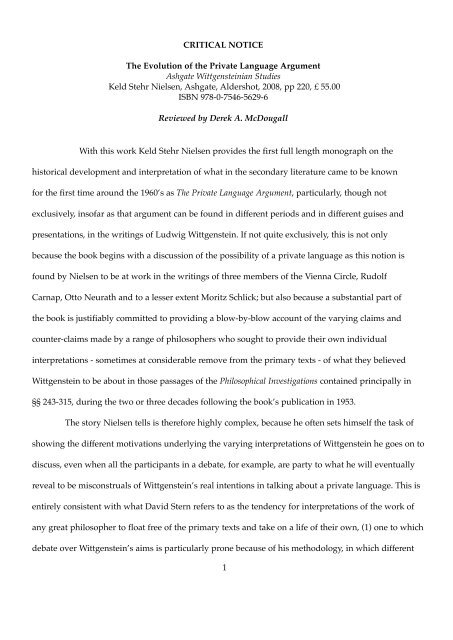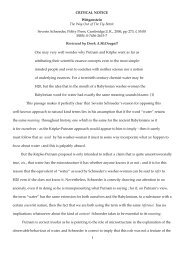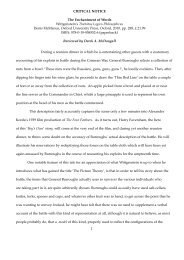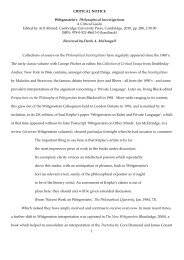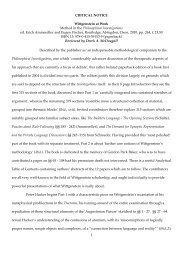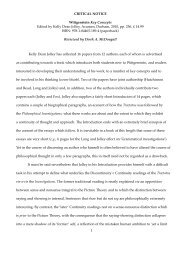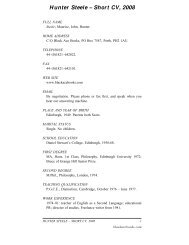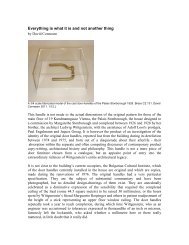The Evolution of the Private Language Argument Aldershot
The Evolution of the Private Language Argument Aldershot
The Evolution of the Private Language Argument Aldershot
Create successful ePaper yourself
Turn your PDF publications into a flip-book with our unique Google optimized e-Paper software.
CRITICAL NOTICE<strong>The</strong> <strong>Evolution</strong> <strong>of</strong> <strong>the</strong> <strong>Private</strong> <strong>Language</strong> <strong>Argument</strong>Ashgate Wittgensteinian StudiesKeld Stehr Nielsen, Ashgate, <strong>Aldershot</strong>, 2008, pp 220, £ 55.00ISBN 978-0-7546-5629-6Reviewed by Derek A. McDougallWith this work Keld Stehr Nielsen provides <strong>the</strong> first full length monograph on <strong>the</strong>historical development and interpretation <strong>of</strong> what in <strong>the</strong> secondary literature came to be knownfor <strong>the</strong> first time around <strong>the</strong> 1960’s as <strong>The</strong> <strong>Private</strong> <strong>Language</strong> <strong>Argument</strong>, particularly, though notexclusively, ins<strong>of</strong>ar as that argument can be found in different periods and in different guises andpresentations, in <strong>the</strong> writings <strong>of</strong> Ludwig Wittgenstein. If not quite exclusively, this is not onlybecause <strong>the</strong> book begins with a discussion <strong>of</strong> <strong>the</strong> possibility <strong>of</strong> a private language as this notion isfound by Nielsen to be at work in <strong>the</strong> writings <strong>of</strong> three members <strong>of</strong> <strong>the</strong> Vienna Circle, RudolfCarnap, Otto Neurath and to a lesser extent Moritz Schlick; but also because a substantial part <strong>of</strong><strong>the</strong> book is justifiably committed to providing a blow-by-blow account <strong>of</strong> <strong>the</strong> varying claims andcounter-claims made by a range <strong>of</strong> philosophers who sought to provide <strong>the</strong>ir own individualinterpretations - sometimes at considerable remove from <strong>the</strong> primary texts - <strong>of</strong> what <strong>the</strong>y believedWittgenstein to be about in those passages <strong>of</strong> <strong>the</strong> Philosophical Investigations contained principally in§§ 243-315, during <strong>the</strong> two or three decades following <strong>the</strong> book’s publication in 1953.<strong>The</strong> story Nielsen tells is <strong>the</strong>refore highly complex, because he <strong>of</strong>ten sets himself <strong>the</strong> task <strong>of</strong>showing <strong>the</strong> different motivations underlying <strong>the</strong> varying interpretations <strong>of</strong> Wittgenstein he goes on todiscuss, even when all <strong>the</strong> participants in a debate, for example, are party to what he will eventuallyreveal to be misconstruals <strong>of</strong> Wittgenstein’s real intentions in talking about a private language. This isentirely consistent with what David Stern refers to as <strong>the</strong> tendency for interpretations <strong>of</strong> <strong>the</strong> work <strong>of</strong>any great philosopher to float free <strong>of</strong> <strong>the</strong> primary texts and take on a life <strong>of</strong> <strong>the</strong>ir own, (1) one to whichdebate over Wittgenstein’s aims is particularly prone because <strong>of</strong> his methodology, in which different1
‘voices’ can play opposing roles in any particular passage ; and in practice this has certainlymeant that many <strong>of</strong> <strong>the</strong> wide variety <strong>of</strong> interpretations to which <strong>the</strong> relevant passages have<strong>of</strong>ten become subject have embodied implicit criticisms <strong>of</strong> Wittgenstein’s ‘argument’ against aprivate language based on <strong>the</strong> very misconceptions he is intent to expose.So what is a private language and why might anyone have thought that itspossibility can in any way be implied by <strong>the</strong> way in which we do talk about our ownsensations ? One point that has to be emphasised from <strong>the</strong> beginning is that <strong>the</strong> notion <strong>of</strong> aprivate language gains what sense it is supposed to have from its intended use to refer towhat is, in a philosophical context, traditionally understood to be private to ourselves in atleast one respectable sense <strong>of</strong> <strong>the</strong> term, something purely phenomenological, <strong>the</strong> ‘felt quality’<strong>of</strong> our individual sensations. Surely <strong>the</strong>se do present <strong>the</strong>mselves to consciousness in everyrelevant respect exactly as <strong>the</strong> kinds <strong>of</strong> sensations that <strong>the</strong>y are, and are exactly as <strong>the</strong>y appear ?And surely this has nothing to do with one’s behaviour in a community <strong>of</strong> o<strong>the</strong>r speakers ?As Saul Kripke succinctly puts it in talking <strong>of</strong> our sensations, ‘Surely I can identify <strong>the</strong>se afterI have felt <strong>the</strong>m, and any participation in a community is irrelevant !’ (2) And again, carefullyemphasising an important aspect <strong>of</strong> <strong>the</strong> debate over what, in <strong>the</strong> view <strong>of</strong> many philosophers,Wittgenstein surely must have meant by a private language, one revealing that his argumentas he presents it is demonstrably invalid, Kripke echoes a <strong>the</strong>me that even today continuesto play a central role in <strong>the</strong> secondary literature:Readers, my previous self certainly included, have <strong>of</strong>ten beeninclined to wonder: ‘How can he prove private language impossible ?How can I possibly have any difficulty identifying my own sensations ?And if <strong>the</strong>re were a difficulty, how could “public” criteria help me ?I must be in pretty bad shape if I needed external help to identify myown sensations !’ (3)In short, our sensations are intrinsically meaningful, and are so independently<strong>of</strong> <strong>the</strong> acquisition <strong>of</strong> a public language. But if Kripke is pointing here to at least one fairly2
acceptable notion <strong>of</strong> privacy, one apparently enshrined in our ordinary talk - yet accompanied inhis presentation by an idea <strong>of</strong> how our sensation terms acquire meaning which readily conformsto what has come to be known as <strong>the</strong> Augustinian Picture - can we take it for granted that this is<strong>the</strong> notion <strong>of</strong> privacy Wittgenstein has in mind when he refers in § 243 to a language used torefer to an individual’s immediate private sensations, one which only he alone can understand ?<strong>The</strong> answer is clearly that that we are talking here about two entirely differentconceptions <strong>of</strong> privacy, one <strong>of</strong> which as presented by Kripke appears to bear some relation toour ordinary sensation talk. For even if this conception does leave him with <strong>the</strong> problem <strong>of</strong>‘o<strong>the</strong>r minds’, <strong>the</strong>re is nothing in his presentation per se to indicate that he is talking about alanguage which only he alone can understand. <strong>The</strong> more strict conception <strong>of</strong> privacy espousedby Wittgenstein, on <strong>the</strong> o<strong>the</strong>r hand, relates to <strong>the</strong> notion <strong>of</strong> a private language which Nielsenfinds firstly in <strong>the</strong> three philosophers <strong>of</strong> <strong>the</strong> Vienna Circle, a notion central to what he refers toas <strong>the</strong> ‘protocol sentence debate’ concerned primarily with ‘how, exactly, traditional empiricismcould survive <strong>the</strong> strictures <strong>of</strong> consistent scientism and <strong>the</strong> verification principle’. (4) <strong>The</strong> point isechoed succinctly by Ayer in his discussion <strong>of</strong> Carnap’s idea <strong>of</strong> a protocol sentence as presentedin his booklet <strong>The</strong> Unity <strong>of</strong> Science, (5) for if a language is to be public it must refer to what ispublicly observable; and since protocol sentences are intended to present a direct record <strong>of</strong>a person’s immediate private experiences, it follows, according to Carnap, that every protocolstatement could only be applied solipsistically, a consequence which on Ayer’s account Carnapis only too keen to avoid:Since Carnap wishes to maintain that people can understand oneano<strong>the</strong>r’s protocol statements, if only on <strong>the</strong> ground that this is anecessary condition for statements made in what he calls <strong>the</strong> physicallanguage to be intersubjectively verifiable, he draws <strong>the</strong> inference that‘protocol language is a part <strong>of</strong> physical language.’ That is, he concludes3
that sentences which on <strong>the</strong> face <strong>of</strong> it refer to private experiencesmust be logically equivalent to sentences which describe somephysical state <strong>of</strong> <strong>the</strong> subject.Despite <strong>the</strong>ir different procedures, Nielsen sees both Carnap’s and Neurath’s privatelanguage arguments as at one in tackling ‘<strong>the</strong> problem <strong>of</strong> explaining how <strong>the</strong> immediately given,or individual experiences, could be embedded into science in a way that does not jeopardize<strong>the</strong>ir crucial justificatory importance. In essence, this was <strong>the</strong> main issue in <strong>the</strong> protocol sentencedebate’. (6) <strong>The</strong> issue for Moritz Schlick is slightly different, for Nielsen takes him to be endorsing<strong>the</strong> idea <strong>of</strong> a private language based very much on what he had supposedly gleaned from a closeassociation with Wittgenstein. This interpretation is strangely at odds with John Cook’s account<strong>of</strong> Schlick’s argument, mentioned by Nielsen, an argument which, according to Cook, inspiredWittgenstein later on to use <strong>the</strong> example <strong>of</strong> a diary in § 258 <strong>of</strong> <strong>the</strong> Investigations. (7) For Cook takesSchlick to follow Wittgenstein in rejecting, ra<strong>the</strong>r than endorsing <strong>the</strong> idea <strong>of</strong> a private language:first person sensation ascriptions express only structure, and do not point to a content <strong>the</strong> nature <strong>of</strong>which only <strong>the</strong> speaker can know. This is an important element in Cook’s claim that Wittgensteinis denying that we have private experiences in <strong>the</strong> sense proposed by <strong>the</strong> dualist:Wittgenstein had two aims in dismissing <strong>the</strong> idea that one speaks<strong>of</strong> ‘content’ , <strong>the</strong> most obvious <strong>of</strong> which was to undermine dualismand <strong>the</strong> skeptical question whe<strong>the</strong>r two people are speaking <strong>of</strong> <strong>the</strong>same content....he had to find an alternative to <strong>the</strong> Tractarian view thatlanguage is pinned to <strong>the</strong> world by means <strong>of</strong> names. His alternative,like Schlick’s, was to deny that one ever speaks <strong>of</strong> ‘content’, whichenabled him to dismiss as absurd <strong>the</strong> idea that, on successive occasions,one speaks <strong>of</strong> <strong>the</strong> same content. (8)But if we study <strong>the</strong> actual passage that Cook uses to show that Wittgenstein isadopting a strictly philosophical position in denying <strong>the</strong> ‘reality’ <strong>of</strong> sensations, what it says4
Rhees in <strong>the</strong>ir equally famous Aristotelian Society encounter. (17) Beginning with what Neilsenchooses to call <strong>The</strong> Reductio <strong>Argument</strong> as initially espoused by Malcolm - Malcolm’s ‘postulatea “private” language ; <strong>the</strong>n deduce that it is not language’ - Neilson claims, surely correctly, thatMalcolm’s presentation <strong>of</strong> what Wittgenstein was saying in § 258 and in surrounding passageswas not only <strong>the</strong> most elaborate but also <strong>the</strong> most influential initial account <strong>of</strong> Wittgenstein’sintentions. It was <strong>the</strong>refore accepted generally by philosophers who were not over-concerned towork out <strong>the</strong> significance <strong>of</strong> § 243 - 315 for <strong>the</strong>mselves. Neilsen summarises Malcolm’s argumentreasonably succinctly: fixing one’s attention on a sensation in order to define <strong>the</strong> meaning <strong>of</strong> aname, followed by a requirement that <strong>the</strong> name be used consistently in <strong>the</strong> future, a requirementdemanding that <strong>the</strong>re be a difference between properly following a rule and being only under<strong>the</strong> impression that one is following a rule. But this requires that <strong>the</strong>re must be somethingindependent <strong>of</strong> one’s impression <strong>of</strong> following a rule, something that is not available in <strong>the</strong>‘private’ case.Strange as it may seem with hindsight, <strong>the</strong>re is actually a reading <strong>of</strong> Malcolm’streatment in which this argument could go through almost as it stands, for if we take it that<strong>the</strong> private linguist is pictured as an element in <strong>the</strong> wrong private-object model for sensationdiscourse, <strong>the</strong>n <strong>the</strong>re will indeed be nothing in which his identifying and re-identifying hissensation correctly could even be taken to consist, for <strong>the</strong>re is nothing after all - apart from ourability to speak English - that grounds our talk <strong>of</strong> having <strong>the</strong> same sensation. It follows that <strong>the</strong>reis nothing that we could understand even to be a proper identification <strong>of</strong> a sensation accordingto this misleading private-object model that supposedly underlies a private language.But one would be hard put to uncover this simple reading from Malcolm’s presentation,and that is why most <strong>of</strong> those who objected to <strong>the</strong> argument as Malcolm presents it, regarded itas an attempt to prove that because <strong>the</strong> so-called private linguist is in no position to know whe<strong>the</strong>rhe is using a word correctly beyond his apparent ability to speak <strong>the</strong> (private) language, it<strong>the</strong>refore makes no sense to say that he can be meaningfully referring to his private sensation.10
But this is simply not true if we adopt <strong>the</strong> assumptions made by those philosophers, Ayer andStrawson, who initially objected to Wittgenstein, for all that <strong>the</strong>y tended to do was argue on <strong>the</strong>(implicit) assumption that since our sensations are intrinsically meaningful to begin with, <strong>the</strong>rewould surely be no difficulty - as Strawson puts it - in claiming that <strong>the</strong> private linguist in <strong>the</strong>course <strong>of</strong> fixing his attention on a sensation in <strong>the</strong> private case ‘might simply be struck by <strong>the</strong>recurrence <strong>of</strong> a certain sensation and get into <strong>the</strong> habit <strong>of</strong> making a certain mark in a differentplace every time it occurred’. (18) That Strawson’s conception <strong>of</strong> a private language is reallythat <strong>of</strong> a language which is in principle public yet used by a solitary individual, is confirmed byhis famously asking in <strong>the</strong> course <strong>of</strong> his discussion - as if this for Wittgenstein could be at allrelevant - whe<strong>the</strong>r we do in practice ever ‘find ourselves misremembering <strong>the</strong> use <strong>of</strong> verysimple words <strong>of</strong> our common language, and having to correct ourselves by attention to o<strong>the</strong>rs’use ?’ (19)<strong>The</strong> same presupposition underlies Ayer’s account, in which his famous RobinsonCrusoe is used to show that a human being raised by wolves in isolation from any normalsocial contact could invent a language for himself, a language which he could eventually teachto Man Friday. Neilsen unusually slips up here, when he takes Ayer to be arguing in favour <strong>of</strong><strong>the</strong> claim that Crusoe’s language ‘could incorporate descriptions <strong>of</strong> sensations which mightturn out to be unintelligible to o<strong>the</strong>r people’, for he uses this to show that Ayer is arguing infavour <strong>of</strong> <strong>the</strong> conclusion that ‘a contingently private language was possible, and that <strong>the</strong>possibility <strong>of</strong> a contingently private language implied <strong>the</strong> possibility <strong>of</strong> a necessarily privatelanguage. Wittgenstein was mistaken.’ (20) But Ayer nowhere endorses <strong>the</strong> possibility <strong>of</strong> alanguage which is necessarily private: all he does is suggest that where Crusoe’s sensationshave no ‘natural expressions’ he may fail to find any way <strong>of</strong> teaching Friday <strong>the</strong> use <strong>of</strong> <strong>the</strong>words to stand for <strong>the</strong>m, which he follows with <strong>the</strong> claim that this does not at all mean that -presumably when <strong>the</strong> sensations do have natural expressions - Man Friday will be incapable11
category to ano<strong>the</strong>r which <strong>the</strong> argument from analogy, or even <strong>the</strong> notion <strong>of</strong> criteria as misunderstood,are supposedly intended to secure.Yet criteria in reality are what enter into our descriptions <strong>of</strong> <strong>the</strong> circumstances in which wedo in practice refer to people who are experiencing pain, suffering deep grief or whatever emotionalor mental states may be in question. <strong>The</strong> degree <strong>of</strong> certainty that an individual is undergoing greatpain or is suffering deep loss is <strong>the</strong>n relative to prevailing circumstances, set against <strong>the</strong> backgroundagainst which we employ <strong>the</strong> criteria determining <strong>the</strong> truth in any particular case. Baker’s and Hacker’sdefeasibility puzzle is <strong>the</strong>n not so much a difficulty for <strong>the</strong> interpretation <strong>of</strong> criteria as a factor whichis integral to <strong>the</strong> framework against which we justifiably make <strong>the</strong> appropriate attributions <strong>of</strong> painor grief. <strong>The</strong> extent to which Wittgenstein turns <strong>the</strong> normal philosophical way <strong>of</strong> thinking aboutthis matter inside out, is once again captured in <strong>the</strong> way in which our innocuously attributing <strong>the</strong>sefeelings to ourselves and to o<strong>the</strong>rs gains its sense from <strong>the</strong> acquisition <strong>of</strong> a public language. Whe<strong>the</strong>r<strong>the</strong>re are indeed criteria in <strong>the</strong> third person but not in <strong>the</strong> first to talk about <strong>the</strong>m, <strong>the</strong>n depends on<strong>the</strong> kinds <strong>of</strong> feelings or sensations in question: a person cannot be wrong about being in pain in <strong>the</strong>way in which he can convince himself <strong>of</strong> feeling deep grief even when he is not. <strong>The</strong> <strong>Private</strong> <strong>Language</strong><strong>Argument</strong> for Wittgenstein was only ever concerned solely with phenomenological aspects <strong>of</strong> privateexperience.In <strong>the</strong> course <strong>of</strong> his purely historical and expository narrative, Neilsen makes no attemptto provide any exposition <strong>of</strong> this kind that from our current perspective might seem to capture a moreadequate account <strong>of</strong> Wittgenstein’s intentions. He takes time to accurately discuss Strawson’s chargein his Review that Wittgenstein gets himself into a muddle in <strong>the</strong> course <strong>of</strong> conflating Strawson’sWeaker <strong>The</strong>sis that certain conditions must be satisfied if <strong>the</strong>re is to be a common language in whichpeople talk about sensations, with his Stronger <strong>The</strong>sis that no words name sensations or privateexperiences. But with <strong>the</strong> benefit <strong>of</strong> hindsight we can see (25) that <strong>the</strong> muddle is Strawson’s, ra<strong>the</strong>rthan Wittgenstein’s, and results from his misunderstanding <strong>of</strong> Wittgenstein, who nowhere denies thatwe ‘name our sensations’ ( § 244). What he denies is that a certain way <strong>of</strong> looking at <strong>the</strong> naming15
<strong>of</strong> sensations which we are prone to adopt when doing philosophy provides <strong>the</strong> proper picture<strong>of</strong> what is involved in calling <strong>the</strong>m by name. Yet even in <strong>the</strong> course <strong>of</strong> pointing out that whenwe refer to ‘<strong>the</strong> taste <strong>of</strong> onions’, this is a taste which is ‘certainly recognisable and identifiablein itself’, Strawson concedes that ‘one does not use criteria <strong>of</strong> identity for <strong>the</strong> taste’, suggestingthat if one asks what <strong>the</strong> criterion <strong>of</strong> identity is here, one can only answer ‘Well, <strong>the</strong> taste itself’.But this is effectively to concede to Wittgenstein <strong>the</strong> point he makes in § 381 when he statesthat ‘I have learnt English’ is an answer to <strong>the</strong> question how he knows that this colour is red.This, however, has to be balanced against o<strong>the</strong>r claims made by Strawson - notmentioned by Neilsen - which are totally at odds with Wittgenstein’s intentions, including hissupposition that <strong>the</strong> private language user would have no proper check on <strong>the</strong> correctness <strong>of</strong>his use <strong>of</strong> it, whe<strong>the</strong>r using memory or not, and that this equally applies to a ‘private language’used to talk about ‘colours or material objects or animals’. He <strong>the</strong>n appears to anticipate SaulKripke in his suggestion that in this case even <strong>the</strong> presence <strong>of</strong> a physical dictionary would notbe sufficient to provide an external check on <strong>the</strong> correctness <strong>of</strong> his use <strong>of</strong> names, because <strong>the</strong>interpretation <strong>of</strong> such a dictionary depends on <strong>the</strong> application that is made <strong>of</strong> it. Strawson endswith <strong>the</strong> suggestion that Wittgenstein’s arguments point towards <strong>the</strong> conclusion that <strong>the</strong> idea<strong>of</strong> a language ‘<strong>of</strong> any kind’ used by only one individual is an absurdity, when it is not made clearwhe<strong>the</strong>r this individual is intended to be isolated in practice or in principle from a surroundingcommunity <strong>of</strong> o<strong>the</strong>r individuals. <strong>The</strong>re remain apparent contradictions in Strawson’s presentationwhich are difficult to resolve.Chapter 6, ‘<strong>The</strong> Availability <strong>of</strong> an <strong>Argument</strong>’, has Nielsen providing a very goodaccount <strong>of</strong> Judith Jarvis Thomson’s famous paper ‘<strong>Private</strong> <strong>Language</strong>s’ from 1964, in whichshe claims that <strong>the</strong> way in which Malcolm presents his Reductio <strong>Argument</strong> would rule out evena public language, since <strong>the</strong> fact that a language is used ‘in isolation’ does not in itself exclude<strong>the</strong> possibility that a speaker can meaningfully talk about his sensations, a point echoed viaAyer’s original assumption that if we presume that from <strong>the</strong> beginning our sensations are16
intrinsically meaningful, <strong>the</strong>n any suggestion that <strong>the</strong> so-called private linguist has no way <strong>of</strong>finding out that he is using his words wrongly will have to turn on an unacceptable appeal tosome form <strong>of</strong> scepticism about memory. This in Neilsen’s judgement means that Thomson hadposed a real problem for Malcolm, whose Reductio <strong>Argument</strong> after a period <strong>of</strong> 10 years was <strong>the</strong>nseen to depend on nothing more than an application <strong>of</strong> <strong>the</strong> verification principle combined witha version <strong>of</strong> memory scepticism. Certainly, Malcolm can be faulted because he does present hiscase in a way which makes him appear to be party to <strong>the</strong> very metaphysical dichotomy thatWittgenstein intended to renounce. Fur<strong>the</strong>rmore, whilst <strong>the</strong> problems Thomson poses are basedon what she takes her reading <strong>of</strong> Malcolm to imply, she does not provide a detailed interpretation<strong>of</strong> Wittgenstein’s original texts in her own terms.<strong>The</strong> remainder <strong>of</strong> Neilsen’s Chapter 6 is devoted to an exposition <strong>of</strong> George Pitcher’sand Alan Donagan’s views on sensation language, and here a revisit to Pitcher’s original bookprovides a worthwhile reminder <strong>of</strong> a certain traditional way <strong>of</strong> looking at sensations:You cannot feel my toothache, nor I yours. But your toothacheis doubtless qualitatively similar to mine, since <strong>the</strong> structures <strong>of</strong>our bodies are very similar. And so, although many words in ourlanguage denote physical things and events which are publiclyobservable, o<strong>the</strong>r words denote items in each <strong>of</strong> our separateconsciousnesses, things directly observable only by <strong>the</strong> one personin whose consciousness <strong>the</strong>y occur. All this seems undeniable. (26)This passage, quoted by Nielsen, is surely <strong>the</strong> perfect introduction to a treatment <strong>of</strong>sensation language allowing for all manner <strong>of</strong> variation on what one might wish to say (whendoing philosophy) about one’s sensations. One might wish to claim with Pitcher, for example, thatsaying that I am in pain is not a way <strong>of</strong> describing what is going on inside me, or that <strong>the</strong> word‘pain’ is not <strong>the</strong> name <strong>of</strong> a sensation. This is not, according to Pitcher, a claim that we do not havesensations, but only that <strong>the</strong>y do not enter into pain language-games. But everything that Pitcher17
says here is evidently based on his attempt to reconcile his initial (philosophical) assumptionswith <strong>the</strong> kinds <strong>of</strong> claims he understands Wittgenstein to be making about our sensations. If wehave no idea what Pitcher’s beetle in his box might be like, that for Pitcher is no drawback,for what it might be like plays no role at all in <strong>the</strong> game, because it is not at all required. (27)If this seems at odds with <strong>the</strong> common temptation to claim (in philosophy) that surely <strong>the</strong> feltquality <strong>of</strong> my sensation plays an essential role in my correctly describing it as <strong>the</strong> kind <strong>of</strong> sensationit is, <strong>the</strong>n one is reminded <strong>of</strong> Wittgenstein’s remark (Investigations § 194) about seeing how high<strong>the</strong> seas <strong>of</strong> language run here, and how a set <strong>of</strong> presuppositions can so determine <strong>the</strong> route thata philosopher’s thinking continues to take that he is prone to regard as a description <strong>of</strong> <strong>the</strong> inmostnature <strong>of</strong> <strong>the</strong> phenomenon under review, what is nothing more than a feature <strong>of</strong> our thinkingallowing us to trace round <strong>the</strong> frame (in our public language) through which we look at it (§ 114).Alan Donagan chastises Pitcher for suggesting that <strong>the</strong> representation <strong>of</strong> pain enters <strong>the</strong>language-game not by referring to a mental object, but by pointing only towards <strong>the</strong> circumstancessurrounding <strong>the</strong> pain-behaviour:This cannot be right. It is true that Wittgenstein denied that painis imaginatively represented by a picture <strong>of</strong> a mental object behind<strong>the</strong> pain behaviour; but that is not <strong>the</strong> same thing as denying that amental object is referred to....At <strong>the</strong> very least, Wittgenstein wasmaintaining that, in <strong>the</strong> Vorstellung <strong>of</strong> pain, reference is made tosomething o<strong>the</strong>r than <strong>the</strong> external circumstances depicted in <strong>the</strong>Bild that corresponds to it. (28)Donagan’s ingenious solution is to treat a sensation as a private non-dispositionalaccompaniment <strong>of</strong> behaviour, something defined by reference to its external circumstances butnot reducible to <strong>the</strong>m. Consequently, if two people correctly claim that <strong>the</strong>y have toothache, <strong>the</strong>n<strong>the</strong>y will characteristically say that <strong>the</strong>y both have something frightful ‘that we would naturallyexpress by holding and rubbing our jaws, by certain kinds <strong>of</strong> grimace, and <strong>the</strong> like.’ Donagan’s18
conclusion, <strong>the</strong>refore, is that, unlike Pitcher, sensations do play a role in <strong>the</strong> language-game, exceptthat ‘Whe<strong>the</strong>r <strong>the</strong> internal character <strong>of</strong> what is expressed in <strong>the</strong>se ways is <strong>the</strong> same for you as forme is irrelevant to <strong>the</strong> meaning <strong>of</strong> <strong>the</strong> word “toothache”.’ Or, as Donagan puts it on <strong>the</strong> precedingpage, ‘<strong>The</strong> existence <strong>of</strong> <strong>the</strong> “object”, <strong>of</strong> that which accompanies natural pain-behaviour, is not onlynot irrelevant to <strong>the</strong> meaning <strong>of</strong> pain words, it is cardinal. What is irrelevant is not <strong>the</strong> existence <strong>of</strong><strong>the</strong> object, but what it happens to be.’ (29)What makes this ingenious solution so interesting is precisely that whe<strong>the</strong>r or not<strong>the</strong>re is something called <strong>the</strong> ‘internal character’ <strong>of</strong> a sensation which ei<strong>the</strong>r is or is not <strong>the</strong> samefor me as for you would be for Wittgenstein ‘a full-blown pictorial representation <strong>of</strong> our grammar’( § 295). <strong>The</strong> philosopher who insists that <strong>the</strong>re surely is a genuine question whe<strong>the</strong>r what is goingon in him is <strong>the</strong> same as what is going on in me is being confused by a picture, in much <strong>the</strong> sameway as is Wittgenstein’s student who tells him whilst striking himself on <strong>the</strong> breast that surely noone else can have this pain ! (§ 252) Once again, <strong>the</strong> only solution whilst doing philosophy, isperhaps to give in to <strong>the</strong> picture, whilst asking how it is to be applied. One way <strong>of</strong> resolving thisdispute is to ask in what circumstances people say that <strong>the</strong>y have <strong>the</strong> same pain, and in whatdescribing it as <strong>the</strong> same is normally taken to consist. This provides a context in which <strong>the</strong>re is aperfectly ordinary way <strong>of</strong> answering <strong>the</strong> question whe<strong>the</strong>r <strong>the</strong> nature <strong>of</strong> <strong>the</strong> pain <strong>the</strong>y are bo<strong>the</strong>xperiencing is <strong>the</strong> same for each <strong>of</strong> <strong>the</strong>m. But that would not be a way <strong>of</strong> pointing to <strong>the</strong> pain(as in a philosophical context) as a member <strong>of</strong> a special kind <strong>of</strong> ontological category.Ano<strong>the</strong>r interesting aspect <strong>of</strong> Donagan’s interpretation <strong>of</strong> Wittgenstein - not mentionedby Neilsen - is his claim that Wittgenstein’s argument in § 258 is fallacious, because Wittgensteinfailed to distinguish between an inability to verify his recollection <strong>of</strong> <strong>the</strong> meaning <strong>of</strong> sensation sign‘E’ with an inability to understand what it would be for his recollection to be right; and from <strong>the</strong>non-existence <strong>of</strong> an independent test for <strong>the</strong> former, it does not follow that <strong>the</strong> so-called privatelinguist could not properly identify and re-identify his sensations. But since this claim by Donaganitself rests on an interpretation <strong>of</strong> what is going on in § 258 that Neilsen will justifiably go on to19
question, <strong>the</strong> point that Donagan is making here - along with Ayer, Strawson, Kripke etc. - maynot be thought to be <strong>of</strong> any ultimate significance.Chapter 7 on ‘Ordinary Sensation <strong>Language</strong>’ is largely occupied with a discussion <strong>of</strong>John Cook who, having been introduced to <strong>the</strong> Wittgenstein <strong>of</strong> <strong>the</strong> Investigations by NormanMalcolm and Oets Bousma, was concerned to show that <strong>the</strong> statement ‘I know I am in pain’ hasno proper application as an expression <strong>of</strong> certainty since, in <strong>the</strong> final analysis, someone whopersistently claims to be in pain when he is not - and is nei<strong>the</strong>r a liar nor is making a slip <strong>of</strong><strong>the</strong> tongue - would be regarded not as having inadequate powers <strong>of</strong> inner observation, but <strong>of</strong>having a poor command <strong>of</strong> <strong>the</strong> English language. This conclusion is intended to break <strong>the</strong>hold <strong>of</strong> <strong>the</strong> suggestion made in § 246 that ‘Well, only I can know whe<strong>the</strong>r I am really in pain;ano<strong>the</strong>r person can only surmise it.’ Along with his treatment <strong>of</strong> ‘Ano<strong>the</strong>r person can’t have mypains’ (§ 253) in which Wittgenstein questions what is supposed to count as a criterion <strong>of</strong> identityhere, Cook’s proposals are seen by Neilsen as an important historical step in <strong>the</strong> literatureundermining <strong>the</strong> attractions <strong>of</strong> <strong>the</strong> so-called ‘Cartesian’ approach in which sensations areassimilated into a special category <strong>of</strong> private ‘mental’ as distinct from ‘physical’ object. IfNeilsen’s treatment here seems to be recounting something with which we are now almost to<strong>of</strong>amiliar, this is no doubt because <strong>the</strong> message from Cook that ‘sensations as private objects’is solely <strong>the</strong> result <strong>of</strong> being under <strong>the</strong> influence <strong>of</strong> a false grammatical analogy, has now becomean accepted feature <strong>of</strong> <strong>the</strong> philosophical landscape. Neilsen is describing here what has come tobe known as ‘early Cook’, and it is no doubt some form <strong>of</strong> testimonial when a philosopher’sthinking is divided into ‘earlier’ and ‘later’ periods. Later Cook does not figure in any detail inNeilsen’s coverage <strong>of</strong> <strong>the</strong> literature, which deals primarily with Cook’s three well-known papersfrom <strong>the</strong> 1960’s and 70’s, pointing in particular to <strong>the</strong> now very familiar ‘Human Beings’ inwhich Cook effectively treats § 258 not as a reductio on Malcolm’s lines, but as a devious heuristicdevice indicating that when severed from <strong>the</strong>ir ordinary contexts <strong>of</strong> application in multifarioushuman activities, attempts to talk about naming and remembering sensations by disembodied20
souls, become unintelligible. This may very well be a reflection <strong>of</strong> <strong>the</strong> influence <strong>of</strong> Bouwsma’s<strong>the</strong>rapeutic approach on Cook, which would be regarded nowadays by some philosophers tohave been ahead <strong>of</strong> its time. Neilsen ends this section, however, by claiming that appeals toordinary language in <strong>the</strong>mselves require to be backed by important discoveries about <strong>the</strong> nature<strong>of</strong> language as such, before a decisive argument against <strong>the</strong> possibility <strong>of</strong> a private language -showing that in some sense language is essentially public - can be invoked. Here Neilsen issurely best regarded as making a point relevant to Wittgenstein’s interpreters ra<strong>the</strong>r than toWittgenstein himself, for whom <strong>the</strong> proposal that language ei<strong>the</strong>r is, or is not essentially public asa statement <strong>of</strong> metaphysical fact would itself have been a symptom <strong>of</strong> confusion.Chapter 8, toge<strong>the</strong>r with parts <strong>of</strong> Chapter 10, prove to contain some <strong>of</strong> <strong>the</strong> moreinteresting discussions in <strong>the</strong> book, for <strong>the</strong>se consider firstly <strong>the</strong> readings <strong>of</strong> § 258, § 265 and § 270by Sir Anthony Kenny which in Neilsen’s estimation come close to capturing what Wittgensteinon private language is really about. Certainly, times have changed: <strong>the</strong>re is just not <strong>the</strong> samedetermination today as <strong>the</strong>re was forty or fifty years ago to discuss what was presumed to be<strong>the</strong> fine argument <strong>of</strong> <strong>the</strong>se passages in <strong>the</strong> detail that used to be regarded as essential, becausemore <strong>the</strong>rapeutic interpretations <strong>of</strong> Wittgenstein’s methodology inevitably tend to emphasise hisconcern to uproot philosophical confusion; and this does not dispose commentators to look for<strong>the</strong> kinds <strong>of</strong> detailed argument which <strong>the</strong>y may not even presume <strong>the</strong>se passages to contain.<strong>The</strong> real difficulty that has occupied <strong>the</strong> innumerable commentators who havediscussed § 258 is that <strong>of</strong> pinpointing just what <strong>the</strong> private linguist’s problem is supposed to be.After all, if we follow <strong>the</strong> thinking <strong>of</strong> Kripke and Ayer, for example, it would appear that <strong>the</strong>reneed be no problem at all: <strong>the</strong> sensations <strong>of</strong> <strong>the</strong>ir private linguist present <strong>the</strong>mselves to him exactlyas <strong>the</strong> kinds <strong>of</strong> sensations that <strong>the</strong>y are, so that <strong>the</strong>re just is no problem <strong>of</strong> ‘identifying’ <strong>the</strong>m and‘reidentifying’ <strong>the</strong>m as <strong>the</strong>y recur, irrespective <strong>of</strong> <strong>the</strong> lack <strong>of</strong> what to Kripke is evidently a quiteincidental ‘public’ context. <strong>The</strong>ir concept <strong>of</strong> privacy is in effect a perfectly ordinary notion <strong>of</strong>21
privacy, just as <strong>the</strong>ir notion <strong>of</strong> a private language is that <strong>of</strong> a version <strong>of</strong> English only usedpurely ‘privately’, i.e., in total isolation from a public context. But it is never made clear whatwould distinguish this supposed isolation in principle from what would be no more than anisolation in practice from a public context, because it is evident that <strong>the</strong>ir concept <strong>of</strong> a ‘private’language is comparable to that <strong>of</strong> <strong>the</strong> philosopher who is given to suddenly imagining himselfwithout a body, unable to communicate with o<strong>the</strong>rs, yet still able to talk to himself inwardlyabout his sensations in a ‘Cartesian’ fashion. Yet Wittgenstein’s objection to this conception <strong>of</strong> aprivate linguist would be methodological ra<strong>the</strong>r than logical: what sense <strong>the</strong> private linguist’sclaims have in this context is based entirely on his prior mastery <strong>of</strong> a public language: <strong>the</strong>claims <strong>of</strong> Kripke’s linguist gain what sense <strong>the</strong>y have only because this individual, whe<strong>the</strong>r nowconceived as a disembodied soul or not, has been surreptitiously segregated from <strong>the</strong> stablebackground in which he originally acquired <strong>the</strong> language he pretends to think <strong>of</strong> as ‘private’.For particular purposes, Wittgenstein would have had no objection to our indulging in this kind<strong>of</strong> fantasy, even if <strong>the</strong> price paid is inevitably that it has no philosophical significance.An importance consequence <strong>of</strong> this understanding <strong>of</strong> what Kripke and Ayer are up to,is that if we assume with <strong>the</strong>m for <strong>the</strong> purposes <strong>of</strong> <strong>the</strong>ir argument that our sensations are in thisway intrinsically meaningful, <strong>the</strong>n <strong>the</strong>re simply cannot be a problem <strong>of</strong> having to invoke someindependent standard in order to distinguish Malcolm’s following a rule from only being under<strong>the</strong> impression that one is following a rule. <strong>The</strong>re may indeed be a separate question at stakeover <strong>the</strong> very idea <strong>of</strong> a born Crusoe inventing a language for himself, which is brought to ahead with <strong>the</strong> thought that whatever he does can be made to appear, on some interpretation,to be in accord with <strong>the</strong> rule he is endeavouring to follow ; but that question with its overtones<strong>of</strong> Platonism v rule scepticism, is just not <strong>the</strong> issue at stake in § 258.So what is ? One answer is to draw <strong>the</strong> inevitable conclusion that <strong>the</strong> problem faced by<strong>the</strong> private linguist is that, initially, his sensations, unlike Kripke’s, are not sensations <strong>of</strong> particularkinds, so that his problem in ‘providing a meaning for his sign S’ is from <strong>the</strong> beginning <strong>the</strong> much22
deeper problem <strong>of</strong> having to confer meaning on his own private world: endowing his signwith meaning is inseparable from converting his bare sensations into sensations which canbe ‘identified’ and ‘reidentified’ under a meaning-rule. <strong>The</strong> question is how this is to beachieved, and <strong>the</strong> answer would appear to be that a connection must be established between<strong>the</strong> sign and <strong>the</strong> sensation, since ‘recognising’ <strong>the</strong> sensation on its recurrence as <strong>the</strong> same, isat least partly what constitutes experiencing again a sensation <strong>of</strong> <strong>the</strong> same kind. But here itmust be remembered that this language is intended to be intrinsically private in a radicalsense, and this requires that <strong>the</strong>se sensations must have individual criteria <strong>of</strong> identity, with <strong>the</strong>consequence that it should be possible simultaneously to have two sensations <strong>of</strong> <strong>the</strong> same kind.This requires that <strong>the</strong>y each must be recognised under a meaning-rule prior to determiningwhe<strong>the</strong>r one <strong>of</strong> <strong>the</strong>m is or is not individually <strong>the</strong> same one as a sensation previously identified.But our very idea <strong>of</strong> an ordinary sensation precludes <strong>the</strong> existence <strong>of</strong> criteria <strong>of</strong> identity allowingfor <strong>the</strong> possibility <strong>of</strong> identifying sensations after this manner. It follows that if, in using thismodel, an attempt is made to identify and reidentify an individual sensation in accordancewith <strong>the</strong> criterionless aspect <strong>of</strong> first person sensation ascription, <strong>the</strong>n ‘whatever is going to seemright to me is right. And that only means that here we can’t talk about “right” ’.On <strong>the</strong> o<strong>the</strong>r hand, if we assume from <strong>the</strong> beginning with Ayer and Kripke thatour sensations are intrinsically meaningful, <strong>the</strong>n criteria <strong>of</strong> identity are not required in talking<strong>of</strong> <strong>the</strong> same sensation, beyond ‘I have learnt English’, and <strong>the</strong>re can be no problem <strong>of</strong> identifyinga sensation as falling under a meaning-rule prior to recording it as <strong>the</strong> same sensation, becausefirst person sensation ascription is criterionless and so without grounds. Certainly, <strong>the</strong> notionthat our sensations are intrinsically meaningful quite independently <strong>of</strong> <strong>the</strong> acquisition <strong>of</strong> a publiclanguage is an element in <strong>the</strong> Augustinian Picture, and Wittgenstein counters this by drawingour attention to <strong>the</strong> common fact that we learn a language in a public context. But this is not aquestion <strong>of</strong> our necessarily acquiring a language in a public context. It points only to <strong>the</strong> principle23
that we cannot even envisage a language which is not intrinsically public, for that in accordancewith <strong>the</strong> criterionless aspect <strong>of</strong> first person sensation ascription is something that has no sense.It is important, <strong>the</strong>refore, to distinguish <strong>the</strong> question <strong>of</strong> how our sensation termsacquire meaning in practice, from <strong>the</strong> distinct question <strong>of</strong> <strong>the</strong> nature <strong>of</strong> first person sensationascription, and whilst Wittgenstein tends to treat <strong>the</strong>m toge<strong>the</strong>r as in <strong>the</strong> last paragraph <strong>of</strong> § 288,<strong>the</strong> issues are quite separate. It is for this reason that if we cut out human behaviour as <strong>the</strong>expression <strong>of</strong> sensation, <strong>the</strong>n it seems we might legitimately doubt afresh only if we are preparedto abandon <strong>the</strong> model <strong>of</strong> first person criterionless sensation ascription in favour <strong>of</strong> <strong>the</strong> model <strong>of</strong>a private object. But that model is illusory, and whilst <strong>the</strong> fantasies <strong>of</strong> Ayer and Kripke are indeedan expression <strong>of</strong> <strong>the</strong> Augustinian picture, <strong>the</strong>y still make sense. <strong>The</strong> fact that <strong>the</strong>y do also reveals<strong>the</strong> extent to which Colin McGinn, for example, goes astray in concluding that Wittgenstein‘invites us to believe that someone whose sensations happen to have no behavioral expressionis semantically impotent in respect <strong>of</strong> those sensations.’ (30) But McGinn is assuming that whatis being provided by Wittgenstein here is a logical argument, when he is doing no more thanissue a reminder <strong>of</strong> <strong>the</strong> circumstances in which we learn how sensation terms are applied.So how far does this account approximate to Kenny’s succinct treatment <strong>of</strong> <strong>the</strong>relevant passages in <strong>the</strong> Investigations ? <strong>The</strong> salient point is actually one that Neilsen findsra<strong>the</strong>r too subtle, one in which Kenny ‘sacrificed clarity for compactness’. (30) <strong>The</strong> referenceis to § 270, and Kenny’s rejection <strong>of</strong> <strong>the</strong> ‘intermediate step’ between having <strong>the</strong> sensation andjudging that one’s blood pressure is rising, a step which would consist in recognising <strong>the</strong>sensation as a sensation <strong>of</strong> a particular kind, prior to judging that this kind <strong>of</strong> sensationindicates a rise in blood pressure. But if this is a normal sensation <strong>of</strong> a particular kind, <strong>the</strong>recan be no intermediate (private) step: <strong>the</strong> distinction between recognising a sensation priorto describing is one that has no application to our ordinary sensation language. <strong>The</strong> differencebetween § 270 and § 258, <strong>the</strong>refore, is that § 258 presents <strong>the</strong> idea <strong>of</strong> a sensation that is notalready an ordinary sensation <strong>of</strong> a particular kind, a sensation which has effectively to be24
identified in terms <strong>of</strong> criteria if it is to be a truly private sensation. <strong>The</strong> gist <strong>of</strong> Kenny’s treatmentand <strong>of</strong> Wittgenstein’s is to show that if a purely private sensation is defined in <strong>the</strong>se terms, <strong>the</strong>n<strong>the</strong>re is nothing that could count as identifiying and reidentifying a sensation purely privately,for <strong>the</strong>re is nothing in which conferring meaning on a purely private sensation term could evenbe taken to consist. This reflects <strong>the</strong> point that if we are, like Kripke and Ayer, to think that wecan name our sensations ‘privately’, <strong>the</strong>n this is possible only because this procedure is beingsurreptitiously divorced from <strong>the</strong> public background against which it habitually takes place.In short, if we are to talk <strong>of</strong> naming our sensations in an uncontroversial way,against <strong>the</strong> background <strong>of</strong> our prior acquaintance with a public language, <strong>the</strong>n meaning mustbe presupposed. Kenny’s arguments against privacy are <strong>the</strong>n no more than a reflection <strong>of</strong> thisprinciple. In his wish to show that ‘This is called “S” ‘ is not a way <strong>of</strong> conferring meaning on“S” in <strong>the</strong> private language, for example, Kenny invites <strong>the</strong> private linguist to answer <strong>the</strong>question what he means by “S”, and proposes three possible answers none <strong>of</strong> which can givehim what he requires. <strong>The</strong> first answer is ‘By “S” I mean this’, when ‘This is “S”’ is not agenuine statement, for what gives it its content is <strong>the</strong> same as what gives it its truth. <strong>The</strong> secondanswer is ‘By “S” I mean <strong>the</strong> sensation I named “S” in <strong>the</strong> past’, when this depends on memoryand it is possible to call up <strong>the</strong> wrong memory, so that ‘whatever is going to seem right to meis right.’ <strong>The</strong> third concerns § 270 which has already been considered.If Kenny’s presentation here seems ra<strong>the</strong>r trite, almost as if he is begging <strong>the</strong>question, this is simply because he is envisaging circumstances in which by definition meaningis not already presupposed, and if it were to be presupposed, <strong>the</strong>n it could be so only in a publiclanguage. But this is not a begging <strong>of</strong> <strong>the</strong> question: it follows from <strong>the</strong> very way in which aprivate language has already been defined. Ayer indirectly makes this point perfectly clear in<strong>the</strong> course <strong>of</strong> presenting an argument in which he certainly does not think that ‘This is “S” ’ ifuttered would be a totally empty proposition:25
<strong>The</strong> recognition consists in treating whatever it may be as aninstance <strong>of</strong> its kind, as being ‘<strong>the</strong> same’ as a previous specimenwhich, if no label has yet been applied to it, may itself beremembered simply as being, in a more or less shadowy context,<strong>the</strong> same as this. If <strong>the</strong> kind has been labelled, <strong>the</strong> disposition toapply <strong>the</strong> same label enters into <strong>the</strong> process <strong>of</strong> recognition; andhere it must not be forgotten that <strong>the</strong> labels <strong>the</strong>mselves have tobe recognised. (31)But Ayer can adopt this procedure here purely because he has already assumedthat our sensations are intrinsically meaningful, an assumption that, for <strong>the</strong> purposes <strong>of</strong> hisargument, he is perfectly free to make, even if this does ultimately make sense from <strong>the</strong>standpoint <strong>of</strong> Wittgenstein’s methodology only against <strong>the</strong> background <strong>of</strong> his prior knowledge<strong>of</strong> a public language. Consequently, if Neilsen is correct in thinking that Kenny comes closerthan most commentators to capturing what is at stake in <strong>the</strong> elaborate scenarios envisagedin <strong>the</strong> three important passages discussed, it is important to clarify exactly what this comesto. If <strong>the</strong>re is one salient point on which <strong>the</strong> presentation given here differs from Kenny’s, itrests on <strong>the</strong> requirement that sensations as identified in <strong>the</strong> private language must each berecognised under a meaning-rule prior to determining whe<strong>the</strong>r one <strong>of</strong> <strong>the</strong>m is or is notindividually <strong>the</strong> same one as a sensation previously identified, a condition requiring <strong>the</strong>background <strong>of</strong> that mock spatio-temporal context referred to earlier on, and rendering <strong>the</strong>very idea <strong>of</strong> a private language inherently absurd. Neilsen suggests that one <strong>of</strong> <strong>the</strong> reasonsKenny has been easily misread along verificationalist lines by Marks and Candlish is that hisargument ‘was at crucial points very hard to decipher and distinguish from a verificationistaccount’ (31); but if we see Kenny’s treatment in <strong>the</strong> right light, this is surely being more thana little unfair to him. Neilsen in any event slightly revises this view in Chapter 10.26
Chapter 10 is Neilsen’s opportunity to pull <strong>the</strong> various strands <strong>of</strong> his previousargumentation toge<strong>the</strong>r in <strong>the</strong> hope <strong>of</strong> providing what he regards as succinct and authoritativeversions <strong>of</strong> those passages within §§ 243-315 - § 258, § 265, § 270, and § 293 - mentioning Candlish,Canfield, Hacker and von Savigny as those whose works can, in his estimation, make <strong>the</strong> strongestclaim to have provided a proper interpretation <strong>of</strong> Wittgenstein. Despite a slight tendency to waffleat <strong>the</strong> beginning over <strong>the</strong> question <strong>of</strong> <strong>the</strong> lack <strong>of</strong> interpretative agreement amongst scholars versusa newly-found pr<strong>of</strong>essional consensus on §§ 243 - 315, <strong>the</strong> Chapter does manage to pull itselftoge<strong>the</strong>r even although it could still have been much improved by being tightened and properlyfocussed on its real objectives. Ultimately, for Neilsen, <strong>the</strong> private linguist’s attempts to confermeaning on his sign are incoherent, because what he is really attempting to do is remember whathis sign means, and this can only presuppose that it is already meaningful: he cannot magicallyendow it with meaning. In this respect, early Kripke is correct after all ins<strong>of</strong>ar as this is only what heis confirming in his implicit claim that his sensations are intrinsically meaningful : unless sensationsappear in every respect as sensations <strong>of</strong> particular kinds - and what could it possibly mean for <strong>the</strong>mnot to ? - <strong>the</strong>re is nothing in which naming <strong>the</strong>m (uncontroversially) could be taken to consist.Wittgenstein’s chain <strong>of</strong> reasoning points to <strong>the</strong> fur<strong>the</strong>r claim - based on <strong>the</strong> need for criteriain <strong>the</strong> private but not in <strong>the</strong> public case - that this makes sense only within a language which is alreadypublic in principle. In <strong>the</strong> course <strong>of</strong> revealing that Candlish misinterprets Kenny by imputing to him aversion <strong>of</strong> memory scepticism, Neilsen reintroduces Kenny as someone who, with Candlish, properlyinterprets Wittgenstein on § 258. Lumping toge<strong>the</strong>r § 270 and § 293 in what he calls <strong>The</strong> Manometer -Beetle <strong>Argument</strong>, Neilsen also stresses that <strong>the</strong> overall point <strong>of</strong> § 270 will be completely misunderstoodunless it is acknowledged that this passage incorporates a transition to ordinary sensation language inwhich sensations are not recognised or identified according to criteria.This point can be expressed by imagining that every time I have a sharp pain in my kneeI discover that my blood pressure rises, but that every time I have a dull pain in my foot my bloodpressure falls. <strong>The</strong> medical explanation for <strong>the</strong>se phenomena need hardly arise. <strong>The</strong> point remains that27
in <strong>the</strong>se cases it is not only going to make a recognisable difference to <strong>the</strong> behaviour <strong>of</strong> <strong>the</strong>manometer whe<strong>the</strong>r I have one kind <strong>of</strong> pain or <strong>the</strong> o<strong>the</strong>r, but also that my correctly predicting <strong>the</strong>manometer reading is going to correspond to my reporting what kind <strong>of</strong> sensation I am having. If,for example, I temporarily forget <strong>the</strong> proper correlation and predict a rise in blood pressure onhaving a dull pain in my foot, <strong>the</strong>n I will have made a quite definite mistake in my prediction. In<strong>the</strong> same way, if I instead make only a slip <strong>of</strong> <strong>the</strong> tongue by saying that <strong>the</strong>re is a rise in bloodpressure when I report a dull pain in my foot, intending to refer to my knee, I will still have made<strong>the</strong> right prediction regardless <strong>of</strong> how clumsy I have been in stating what I feel, since this slip <strong>of</strong><strong>the</strong> tongue was no part <strong>of</strong> my intention. It <strong>the</strong>n follows that when Wittgenstein talks <strong>of</strong> its beingquite indifferent whe<strong>the</strong>r I have recognised <strong>the</strong> sensation right or not, he is ei<strong>the</strong>r referring to aprivate object that has no part to play in talking about our sensations, because it is only on thisinapplicable model that a question <strong>of</strong> correct or incorrect recognition arises, or he is simplyreiterating <strong>the</strong> point that since a question <strong>of</strong> recognition does not arise in those cases where wetalk about our ordinary sensations, <strong>the</strong> private object drops out <strong>of</strong> consideration altoge<strong>the</strong>r.Neilsen is justified in concluding that a similar point is being made in § 293 - and incidentally in§§ 271-2 - where <strong>the</strong> vivid imagery <strong>of</strong> <strong>the</strong> Beetle in <strong>the</strong> Box is no more than a reminder that ifwhen doing philosophy <strong>the</strong> tendency is to reify private objects in this fashion, <strong>the</strong>n we will betempted to ask <strong>the</strong> kinds <strong>of</strong> questions asked by Pitcher and Donagan, who were prone to querywhe<strong>the</strong>r <strong>the</strong>re really are private sensations which are qualitatively <strong>the</strong> same for each <strong>of</strong> <strong>the</strong>m.Neilsen remarks at <strong>the</strong> end <strong>of</strong> Chapter 10 that Wittgenstein’s treatment <strong>of</strong> aprivate language nowhere excludes <strong>the</strong> possibility <strong>of</strong> an infant Robinson Crusoe inventing alanguage for himself, so making Crusoe a potential speaker. Here it is almost as if he is oblivious<strong>of</strong> Wittgenstein’s point that our attraction to Crusoe is symptomatic <strong>of</strong> our being party to apicture which is doing no real work, one which underlies <strong>the</strong> philosophical urge to talk at a moresophisticated level about innate conceptual capacities and intrinsically meaningful sensationswhich can be named prior to <strong>the</strong> acquisition <strong>of</strong> a public language.28
<strong>The</strong> intermediate Chapter, No. 9 in which Neilsen discusses ‘<strong>The</strong> Rule-FollowingConsiderations’ central to Saul Kripke’s picture <strong>of</strong> Wittgenstein as a rule sceptic providing a‘sceptical solution’ to a sceptical paradox, will inevitably appear - to those who adhere to thisversion <strong>of</strong> <strong>the</strong> private language argument in <strong>the</strong> Investigations - to embody a misrepresentation<strong>of</strong> <strong>the</strong> real meaning <strong>of</strong> <strong>the</strong> rule-following passages: Kripke argues that §§ 243-315 are a specialcase <strong>of</strong> what is going on in §§ 138-242. Certainly, Kripke’s treatment does appear to be something<strong>of</strong> an anomaly from Neilsen’s historical perspective, but <strong>the</strong> linear progression he discovers inrevealing <strong>the</strong> evolution <strong>of</strong> <strong>the</strong> argument about sensations as it has developed in <strong>the</strong> literaturesuggests that <strong>the</strong>re are very good reasons for adopting <strong>the</strong> traditional view that §§ 243-315require separate treatment. But Neilsen has an additional justification for thinking that Kripkeand Wittgenstein have different agendas, for he sees <strong>the</strong> sceptical paradox as an expression <strong>of</strong><strong>the</strong> closed picturing function <strong>of</strong> language in <strong>the</strong> Tractatus, in contrast to <strong>the</strong> role <strong>of</strong> language in<strong>the</strong> Investigations: as an open-textured and constantly developing and changing medium, ameans <strong>of</strong> communication set against a background <strong>of</strong> social customs and institutions.Whilst Neilsen would be <strong>the</strong> first to claim that this description is probably too brief tobe <strong>of</strong> any real value as it stands, and whilst <strong>the</strong>re has been occasion to quote Kripke here only inrelation to a viewpoint <strong>of</strong> his ‘early self’ shared with Ayer in which he is shown to adhere to animportant element in <strong>the</strong> Augustinian Picture, it would be better to see Wittgenstein’s reactionto his sceptical paradox - which is generally agreed to differ in detail from Kripke’s - as afur<strong>the</strong>r reaction to a picture; and <strong>the</strong> characteristic question he asks <strong>of</strong> a picture is what is to bedone with it ? How is it to be used ? He does not answer <strong>the</strong> sceptical paradox expressed in<strong>the</strong> picture by saying that we really do act in accordance with a rule which stretches to infinity,any more than he answers <strong>the</strong> problem <strong>of</strong> o<strong>the</strong>r minds expressed in <strong>the</strong> picture by claimingthat we really do have direct access to <strong>the</strong> thoughts and feelings <strong>of</strong> o<strong>the</strong>rs: <strong>the</strong>se requirementsare <strong>the</strong> source <strong>of</strong> <strong>the</strong> philosophical confusions <strong>the</strong> pictures serve to express. In § 201, ‘It can beseen that <strong>the</strong>re is a misunderstanding here....’ is a way <strong>of</strong> once again drawing attention to <strong>the</strong> fact29
that when doing philosophy, in this case ‘we gave one interpretation after ano<strong>the</strong>r’, as if we could notbe content with any one <strong>of</strong> <strong>the</strong>m because we were under <strong>the</strong> spell <strong>of</strong> a picture which had no genuineapplication, a point emphasised in his immediate reference to <strong>the</strong> everyday contexts in which wenaturally ‘obey <strong>the</strong> rule’ and ‘go against it’ in actual cases. <strong>The</strong> problem <strong>of</strong> o<strong>the</strong>r minds, like <strong>the</strong>sceptical paradox, has no answer at <strong>the</strong> level <strong>of</strong> <strong>the</strong> question, because <strong>the</strong> question is itself a reflection<strong>of</strong> <strong>the</strong> very picture requiring <strong>the</strong> philosopher to turn <strong>the</strong> investigation around in order to relinquishits hold: only <strong>the</strong>n can <strong>the</strong> philosophical landscape be viewed from a wholly different perspective.In <strong>the</strong> final analysis, Neilsen’s book makes for a very good read. It is a highly competenthistorical account bristling with argument on every page. He is at his best in reviewing this argument.It is <strong>of</strong>ten better avoiding <strong>the</strong> kind <strong>of</strong> broad historical overviews instantly requiring minor or even majorqualification. Perhaps he could have drawn attention to <strong>the</strong> <strong>the</strong>rapeutic approaches to Wittgenstein’sphilosophy which became more prominent from <strong>the</strong> 1990’s - <strong>the</strong> change in Gordon Baker’s work beinga prime example - and perhaps he could have related this to how a perspective on private languagemay be reflected in <strong>the</strong> much-discussed Diamond-Conant interpretation <strong>of</strong> <strong>the</strong> Tractatus. Diamond’spaper on <strong>the</strong> private language argument she discovers in <strong>the</strong> Tractatus is particularly relevant. But<strong>the</strong>se are minor points in an o<strong>the</strong>rwise significant achievement.Pro<strong>of</strong>-reading could have been considerably improved. In <strong>the</strong> last chapter alone, six pageslong, providing a brief review <strong>of</strong> Wittgenstein and contemporary philosophy, <strong>the</strong>re is a characteristic‘Here is bold statement <strong>of</strong> <strong>the</strong>se conclusions’ at <strong>the</strong> beginning <strong>of</strong> paragraph 4, on page 178; a referenceto ‘Hutchinson/Read (2005)’ at <strong>the</strong> foot <strong>of</strong> this page which cannot be found in <strong>the</strong> Bibliography; andano<strong>the</strong>r ‘It would misleading not to mention Sellars and Quine...’ on page 181 paragraph 3, line 3.<strong>The</strong>re are too many instances <strong>of</strong> missing definite and indefinite articles and prepositions, occasionalunnecessary use <strong>of</strong> <strong>the</strong> definite article, with rarer faults <strong>of</strong> English idiom. On page 61, penultimateparagraph, Neilsen understands Strawson’s claim that in reading this section <strong>of</strong> <strong>the</strong> Investigations‘one may well feel one’s capacity to learn coming to an end’ to mean that <strong>the</strong> relevant passages arevery difficult to understand, when it is instead a compliment to <strong>the</strong> author suggesting that his writingis so rich in content that it can take an unusually long time to absorb.30
ENDNOTES(1) David Stern: Wittgenstein on Mind and <strong>Language</strong> (Oxford: Oxford University Press 1995), 175.(2) Saul Kripke: Wittgenstein on Rules and <strong>Private</strong> <strong>Language</strong> (Oxford: Basil Blackwell 1982), 80.(3) Kripke, Ibid., 60.(4) Nielsen, 26.(5) A.J. Ayer ‘Can <strong>The</strong>re be a <strong>Private</strong> <strong>Language</strong>?’ in Wittgenstein <strong>The</strong> Philosophical InvestigationsEd. George Pitcher (New York: Doubleday Anchor 1968), 253.(6) Nielsen, 25.(7) Nielsen, 56 and Note 12.(8) John Cook: Wittgenstein’s Metaphysics (Cambridge: Cambridge University Press 1994), 331.(9) Ludwig Wittgenstein: Philosophical Occasions (Indianapolis: Hacket Pub. 1993), Rush Rhees:Wittgenstein’s Lectures 1936 ‘<strong>The</strong> <strong>Language</strong> <strong>of</strong> Sense-Data and <strong>Private</strong> Experience, 340.(10) David Stern: ‘Wittgenstein, <strong>The</strong> Vienna Circle and Physicalism: a Reassessment’ <strong>The</strong> CambridgeCompanion to Logical Empiricism (Cambridge: Cambridge University Press 2007), 305.(11) Cora Diamond: “Does Bismarck Have a Beetle in His Box? ” in <strong>The</strong> New Wittgenstein(Routledge: London 2000), 278.(12) Ludwig Wittgenstein: Ludwig Wittgenstein and <strong>The</strong> Vienna Circle - Conversations recorded byFriedrich Waismann, (Oxford: Oxford University Press, 1979), quoted Neilsen: Ibid.,29.(13) Philosophical Occasions, Ibid., 450.(14) Ibid., 454.(15) Ibid., 451 et seq.(16) Neilsen, 54.(17) Pitcher, ed. 1968 contains all <strong>the</strong> relevant papers.(18) Strawson in Pitcher ed. 1968, 44.(19) Ibid.(20) Neilsen, 69.(21) In, for example, A.J.Ayer: Wittgenstein (London: Weidenfeld and Nicolson, 1985), 74 -75.(22) Neilsen, quoted 71.(23) Malcolm in Pitcher ed. 1968, 380-81.(24) G.P. Baker & P.M.S. Hacker: Scepticism, Rules and <strong>Language</strong> (Oxford: Basil Blackwell, 1984), 111.(25) Malcolm in Pitcher ed. 1968, 42-45.(26) George Pitcher: <strong>The</strong> Philosophy <strong>of</strong> Wittgenstein (New Jersey: Prentice-Hall, 1964), 281.(27) Neilsen, 97.(28) Donagan in Pitcher ed. 1968, 332.(29) Ibid., 347.(30) Colin McGinn: “Budd: Wittgenstein’s Philosophy <strong>of</strong> Psychology”, Minds and Bodies: Philosophersand <strong>The</strong>ir Ideas (Oxford: Oxford University Press, 1997) 188. A clear echo <strong>of</strong> Kripke.(31) A.J. Ayer: “Reply to David Pears”, <strong>The</strong> Philosophy <strong>of</strong> A.J.Ayer ed. L.E. Hahn(La Salle Illinois: Open Court, 1992) 403.31
As do most philosophers, Derek McDougall fondly remembers <strong>the</strong> publication<strong>of</strong> his very first paper. This was in MIND in 1972. He has, however, continuedto worry whe<strong>the</strong>r Gilbert Ryle’s comment that “<strong>the</strong> matter is stated well andalmost interestingly” referred more to <strong>the</strong> quality <strong>of</strong> its treatment ra<strong>the</strong>r than toRyle’s aversion to <strong>the</strong> nature <strong>of</strong> its subject (religious belief). O<strong>the</strong>r papers haveappeared in organs including PHILOSOPHY AND PHENOMENOLOGICALRESEARCH and PHILOSOPHIA. His latest, on Wittgenstein, appears in <strong>the</strong>2008 edition <strong>of</strong> JOURNAL OF PHILOSOPHICAL RESEARCH.32


